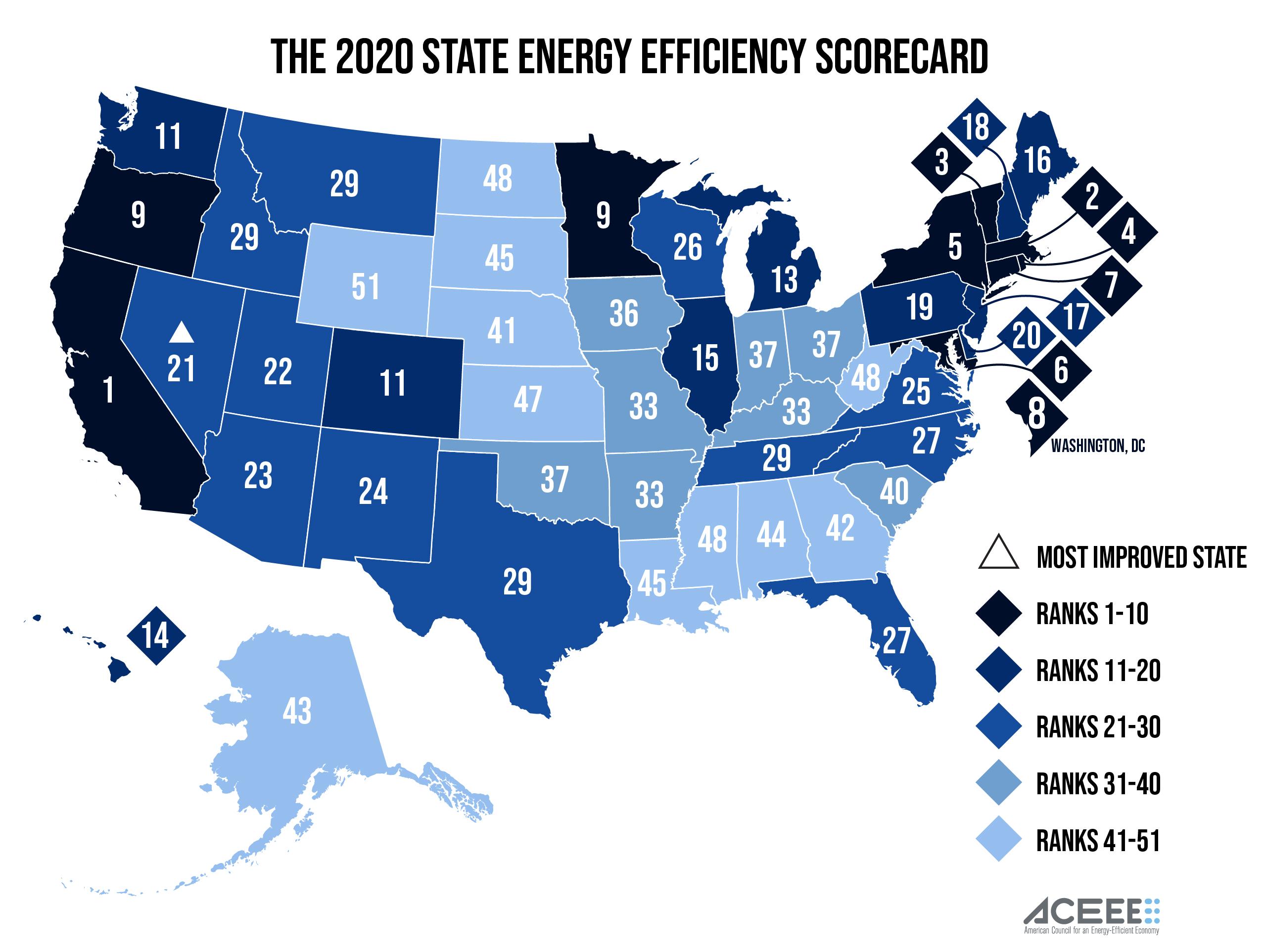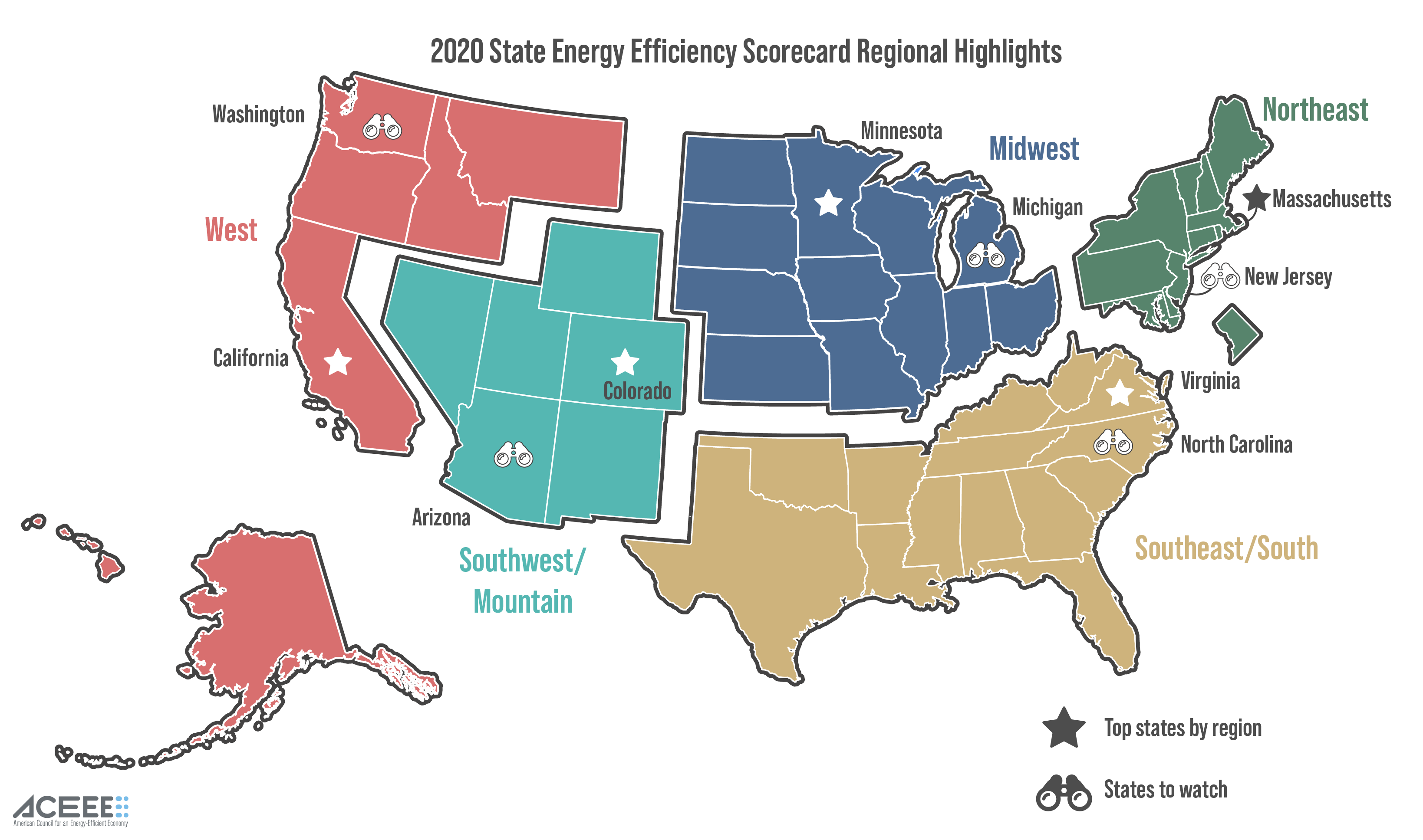Scorecard: Energy-Saving Efforts Continue, Albeit at a Slower Pace
The American Council for an Energy-Efficient Economy’s annual ranking posts uneven performance across the map.
The year 2020 was challenging for the energy sector. Following a vibrant 2019, when energy-efficiency efforts and climate goals advanced considerably, the worldwide pandemic abruptly shifted focus. Local officials had to reorganize their priorities to mitigate the health and economic impacts of the health crisis. As a result, momentum slowed on many efforts to advance energy-saving policies, but even with the added challenges, most states made progress in energy-efficiency initiatives.
In mid-December, the American Council for an Energy-Efficient Economy released the 14th edition of the State Energy Efficiency Scorecard. The ranking analyzes the efforts of all 50 U.S. states and Washington, D.C., based on their policies and programs to reduce energy use. The 32 metrics reviewed by the entity include the adoption and advancement of energy-saving targets, vehicle rules and appliance standards, just to name a few.
ACEEE’s findings reflect uneven performance across states, with some deeply impacted by the health crisis. Still, some states managed to record substantial progress.
Leading states
California regained the top position, scoring 43 points out of a possible 50, a half-point less than it earned last year. Throughout 2020, the state has shown exceptional leadership in building energy codes, vehicle emissions and appliance standards, which has prompted other states to model their own policies after California’s applications. More than a dozen states adopted its low-emissions vehicle regulations and 11 other states have adopted its zero-emissions vehicle program. Moreover, an executive order signed by Gov. Gavin Newsom in September called for phasing out the sale of gasoline-powered vehicles by 2035.
The state’s energy code is one of the most aggressive in the country, and this has boosted energy efficiency standards for building equipment. The latest codes are the first in the U.S. to require low-rise residential buildings to have photovoltaic systems sized to meet the building electricity load that remains after all energy efficiency requirements are met. In addition, the state’s building energy codes were updated to award compliance credits for smart heat-pump water heaters in recognition of their grid benefits.
California was also the first state in the country to adopt appliance and equipment efficiency standards. Among the recently passed bills is SB 49, which directs the California Energy Commission to develop standards for appliances related to flexible demand technologies that reduce statewide greenhouse gas emissions and improve the resiliency of the state’s electricity grid.
READ ALSO: Energy Efficiency Scorecard: Rating the States
Massachusetts ranked second with 43.5 points, two points less than it earned in 2019. The state leads the nation in the levels of the utility savings recorded and its programs and policies designed to strengthen efficiency in the building and transportation sectors. Recent plans allow program administrators to deliver a wider variety of measures—such as energy storage, renewable energy and strategic electrification—and give flexibility in leveraging energy efficiency to reduce emissions. Moreover, utility revenues are decoupled from sales and performance incentives are in place to encourage program administrators to meet or exceed energy savings targets.
The state’s set of efficiency transportation policies includes tailpipe emissions standards, targets to reduce vehicle miles traveled, significant levels of transit funding and a dedicated transit revenue stream. Moreover, Massachusetts has a comprehensive freight plan and offers incentives to consumers for the purchase of high-efficiency vehicles. The state has more electric vehicle registrations and public charging stations per capita than most states. In addition, it incentivizes the creation of low-income housing near transit facilities and considers the proximity of transit facilities when distributing federal low-income housing tax credits to qualifying property owners.
Massachusetts’ state government set energy requirements for public buildings and fleets—benchmarking energy use—and encourages the use of energy savings performance contracts. Furthermore, the state is a member of the Regional Greenhouse Gas Initiative and reinvests cap-and-trade proceeds toward energy efficiency.
READ ALSO: IEA’s World Energy Outlook 2020
Vermont marked its seventh year in the Scorecard Top 5 and occupies the third position in the ranking with 40 points, a half-point less than it earned last year. Efficiency Vermont, a statewide energy efficiency utility, helps it achieve high levels of electricity and natural gas savings. Electric and natural gas utilities within the state are decoupled.
The state has adopted California’s Low-Emission Vehicle and Zero-Emission Vehicle programs, has passed complete-streets legislation and has policies integrating transportation and land-use planning. Vermont has more electric vehicle registrations and public charging stations per capita than most states and is one of only a few states with codified targets for reduced vehicle miles traveled. In June 2019, the state passed HB 529, increasing public transit funding, offering financial incentives for plug-in electric vehicles and setting a 2021 target to make 75 percent of purchased or leased vehicles for its state vehicle fleet fully electric or hybrid.
Vermont updates its building codes every three years. The state’s 2020 building energy standards took effect in September and include energy-efficiency requirements from the 2018 International Energy Conservation Code and American Society of Heating, Refrigerating and Air Conditioning Engineers Standards. In addition, it is a member of the Regional Greenhouse Gas Initiative and reinvests cap-and-trade proceeds toward energy efficiency. The state’s appliance standards are expected to save consumers 435 million gallons of water and 59 million kilowatt-hours of electricity annually, equating to about $17 million in savings per year.
Rhode Island and New York round-up the Scorecard’s Top 5 positions. Next in line are Maryland, Connecticut and Washington, D.C., while Minnesota and Oregon both occupy the ninth position.
The bottom five states, each earning seven points or fewer, are Kansas (No. 47, nationally), Mississippi (No. 48), North Dakota (No. 48), West Virginia (No. 48) and Wyoming (No. 51).
READ ALSO: Peak Carbon Emissions Fall, But Faster Decline Needed
Visual courtesy of ACEEE
Top scorers regionally
For the first time since the Scorecard’s inception in 2007, the analysis includes top scorers regionally. California leads the nation and the Western U.S. and Massachusetts leads the Northeast. In the remaining regions the following states posted remarkable performance:
In the Midwest, Minnesota took the lead. The state reported strong results from utility-run programs that help customers save energy. In addition, Minnesota is in the process of developing draft rules for a clean cars program that would adopt California’s tailpipe and zero-emission vehicle standards.
The Southwest/Mountain region is led by Colorado (No. 11, nationally). Officials are working on plans to meet statewide climate goals signed last year, which target a 90 percent reduction in greenhouse gas emissions by 2050. A roadmap to meet those goals was released by Gov. Jared Polis last September.
The leader in the South/Southeast region is Virginia (No. 25, nationally). The state wrote a top energy story in 2020, adopting its first energy-saving target—known as an energy efficiency resource standard—and raised minimum funding levels for efficiency programs for low-income, elderly and disabled individuals and veterans. Virginia is the first Southeastern state to set a 100 percent clean electricity goal.
States to watch
Nevada performed the best and moved up five places to No. 21. The state has adopted standards for light bulbs, strengthened building energy codes and begun implementing strong vehicle standards. At the opposite end, Iowa lost 13 positions and fell to No. 36. The slide is attributed to legislation passed in 2018 that capped certain efficiency investments, leading to a steep decline in progress in reducing electricity and gas use. Advancement is expected in New Jersey, Michigan, North Carolina, Arizona and Washington.









You must be logged in to post a comment.